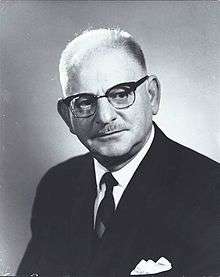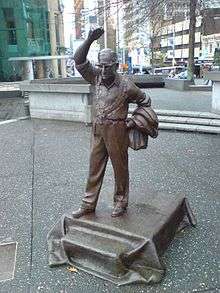Dove-Myer Robinson
| Sir Dove-Myer Robinson | |
|---|---|
 | |
| 32nd Mayor of Auckland City | |
|
In office 1959–1965 | |
| Deputy |
See list
|
| Preceded by | Keith Buttle |
| Succeeded by | Roy McElroy |
|
In office 1968–1980 | |
| Deputy |
See list
|
| Preceded by | Roy McElroy |
| Succeeded by | Colin Kay |
| Personal details | |
| Born |
15 June 1901 Sheffield, England |
| Died |
14 August 1989 (aged 88) Auckland, New Zealand |
| Relations | Dame Barbara Goodman |
Sir Dove-Myer Robinson (15 June 1901 – 14 August 1989) was Mayor of Auckland City from 1959 to 1965 and from 1968 to 1980, the longest tenure of any holder of the office.[1] He was a colourful character and became affectionately known across New Zealand as "Robbie".[2] He was one of several Jewish mayors of Auckland, although he rejected Judaism as a teenager and became a lifelong atheist.[3] He has been described as a "slight, bespectacled man whose tiny stature was offset by a booming voice and massive ego".[3]
Biography
Early life and career
Born Mayer Dove Robinson in Sheffield, England, he was the sixth of seven children of Ida Brown and Moss Robinson. While his father described himself as a master jeweller, he actually sold trinkets and second-hand furniture, and the family was poor and often on the move. Robinson's mother influenced his upbringing by transmitting the strict values her rabbi father had taught her. His Jewish heritage ensured that he was often targeted by anti-semitic violence in the schools he attended. The family moved to New Zealand in 1914, where his father worked as a pawnbroker. Dove-Myer, as he later called himself (ignoring his Robinson family name), found New Zealand agreeable and lacking in the intermittent persecutions he had previously faced.[3]
Political activism
Robinson entered politics in the late 1940s when he led the opposition to a sewage dumping scheme that would have discharged untreated effluent into the Hauraki Gulf. When elected in a 1952 by-election as a councillor, he proposed and eventually realised a scheme to break down the sewage in oxidation ponds ('Robbie's ponds') near the Manukau Harbour. His success in the scheme later on helped him gain the popularity to be elected Mayor of Auckland City.[1]
Mayor of Auckland City
In 1959, campaigning on a populist platform as "Robbie" he defeated the incumbent Citizens & Ratepayers mayor Keith Buttle which caused much resentment. A hallmark of Robinson's first two terms as mayor was the perpetual animosity between himself and the Citizens & Ratepayers councillors, who despised Robinson’s popularity, working-class origins and social conduct.[3] Robinson's main drive in his first period as mayor was a proposed merging of the 32 separate city, borough and county councils in greater Auckland into a regional authority that could collectively decide on issues of regional importance. He won over smaller councils (who mostly opposed the reforms) and exploited Parliamentary recommendations for compulsory council amalgamations to forge the issue ahead successfully on condition that the existing councils were left intact. In 1963 The Auckland Regional Authority (ARA) was established and Robinson was chosen as its founding chairman.[4]
After being re-elected in 1962, Robinson lost the 1965 mayoral election by 1134 votes to Citizens & Ratepayers candidate Roy McElroy, but in the next election in 1968 he in turn defeated McElroy by 6000 votes becoming the first Mayor of Auckland to serve non-consecutive terms. Also in 1968 he was appointed to the transit committee of the ARA where he advocated for rapid rail system for Auckland. The scheme was heavily criticized for its cost and the ARA chairman Tom Pearce and most members opposed the scheme. The Third Labour Government reneged on an election pledge to pay for the scheme and the rapid rail proposal disappeared. Retrospectively, Robinson's idea to implement rapid rail was seen as a possible long-term solution to Auckland's subsequent transportation difficulties. The phrase; "If we'd only listened to Robbie..." has become common speech in Auckland whenever the city's transport system is debated.[5]
During his career, Robinson also became involved in the incipient movement of Green politics, particularly the anti-nuclear movement, and supported the Third Labour Government's opposition to French nuclear testing in the Pacific.[3]
Later life and death
Robinson died in Auckland on 14 August 1989.[3]
Remembrance

Dame Barbara Goodman, former Auckland Mayoress and councillor, was his niece, and spearheaded a campaign for the Auckland City Council to build a statue of him in Aotea Square; the statue was completed in 2002.[6]
See also
References
- 1 2 Robbie's Ponds (from Te Ara: The Encyclopedia of New Zealand. Accessed 6 June 2008.)
- ↑ Dove-Myer Robinson [with appropriately colourful picture] Archived 5 September 2008 at the Wayback Machine. (from Te Ara: The Encyclopedia of New Zealand. Accessed 2008-06-06.)
- 1 2 3 4 5 6 Edgar, John. "Robinson, Dove-Myer". Dictionary of New Zealand Biography. Ministry for Culture and Heritage. Retrieved 8 July 2017.
- ↑ John Edgar 2012 Urban Legend Sir Dove-Meyer Robinson. Hodder Moa.
- ↑ "The man who saved the harbour". The New Zealand Herald. 2 May 2015. Retrieved 8 October 2018.
- ↑ Statue of Sir Dove-Myer Robinson Archived 16 October 2008 at the Wayback Machine. (from the Auckland City Council website. Accessed 6 June 2008.)
| Political offices | ||
|---|---|---|
| Preceded by Keith Buttle |
Mayor of Auckland City 1959–1965 1968–1980 |
Succeeded by Roy McElroy |
| Preceded by Roy McElroy |
Succeeded by Colin Kay | |